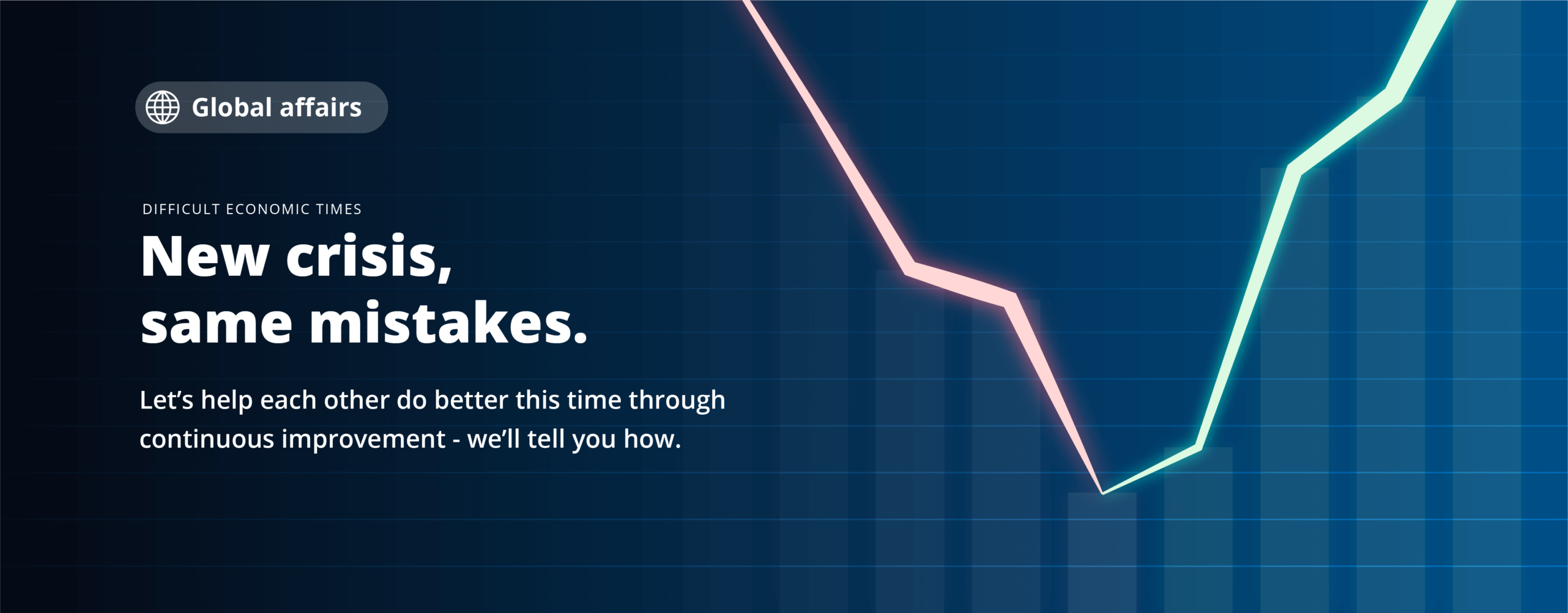
Goal-setting Frameworks: a comparison between Hoshin Kanri and OKR
Ever participated in a Lean Six Sigma project or worked alongside of Continuous Improvement professionals? Then you will probably have heard it mentioned how big of a role organizational culture plays. And if not, then there’s something missing. Because let us tell you: the effectiveness of Lean Six Sigma initiatives and policies is closely tied to the degree with which the methodology is understood and embraced.
As culture almost always flows top-down, organizations which are truly dedicated to continuous improvement therefore know it is vital to involve the management layer. While the isolated actions of a single Lean Six Sigma practitioner or team might be inspiring, it isn’t the way forward. To get the most out the methodology, you need to properly translate the company vision and mission into well thought-out goals and strategies in a way that involves all layers.
We would like to highlight two frameworks which lend themselves for this, namely Hoshin Kanri and Objectives and Key Results (OKR). We go over the pros and cons of each to see which one is most suited to your situation and the best choice if you’re looking to chase down that elusive culture of continuous improvement.
The basics of Hoshin Kanri
Hoshin Kanri is a strategic planning methodology which originated in 1950’s Japan. It was developed by Professor Yoji Akao, who was a quality control engineer at the Bridgestone Tire Company at the time.
Professor Akao’s goal was to create a systematic approach to strategic planning that would align an organization’s goals and objectives with its daily operations. He believed that a well-designed Hoshin Kanri system would enable an organization to focus its efforts on achieving long-term goals while still maintaining a high level of performance in the short term.
Over the years, Hoshin Kanri evolved and been refined, and it is now widely used by organizations around the world as a key tool for strategic planning and execution
It is also known as “Policy Deployment” in English. The term “Hoshin” refers to the compass or direction, while “Kanri” means management. So Hoshin Kanri can be translated as anything along the lines of “compass management,” “policy management,” or “direction management.”
Hoshin Kanri aims to align the goals and objectives of an organization with its strategic plans, by involving all levels of employees in the planning and execution process. It is a collaborative approach that involves multiple stakeholders in creating a shared vision and action plan, and then executing that plan through a series of initiatives and projects.
The Hoshin Kanri methodology involves a set of steps, which typically includes defining the organization’s vision, creating a strategic plan, setting annual goals and targets, aligning resources and initiatives, and tracking progress against the plan.
Hoshin Kanri Pros:
- It aligns the organization’s goals and objectives with its overall strategy, ensuring that everyone is working towards the same vision.
- With Hoshin Kanri, you encourage participation and collaboration from all levels of the organization, creating a sense of ownership and accountability.
- Hoshin Kanri promotes continuous improvement through regular reviews and updates to the strategic plan and goals.
- With Hoshin Kanri you provide a structured approach to prioritizing initiatives and projects, ensuring that resources are allocated to the most critical areas.
- Hoshin Kanri improves communication across the organization by establishing a shared understanding of the strategy and goals.
Downsides/Cons:
- Hoshin Kanri can be a time-consuming process, requiring significant effort to define and communicate the strategic plan, set goals, and monitor progress.
- Implementing Hoshin Kanri requires a cultural shift towards collaboration and continuous improvement, which can be challenging for organizations with a more traditional hierarchy.
- Sometimes, Hoshin Kanri can be overly complex if not implemented correctly, leading to confusion and frustration among employees.
- Likewise, it can be too rigid if not adapted to the organization’s changing needs and priorities, it’s not a one-time effort.
- Lastly, Hoshin Kanri does require some investment (training, resources, and technology) which can be expensive for some organizations.
The basics of OKR
OKR stands for Objectives and Key Results. It is a goal-setting framework used by organizations to define and track objectives and outcomes. OKRs were popularized by Google, where they have been
used to drive growth and success for the company. It was developed by Andy Grove, the former CEO of Intel, in the 1980s. Grove introduced OKRs as a way to align the company’s goals and objectives with individual performance metrics.
It’s worth noting that John Doerr, a venture capitalist and former employee of Intel, is often credited with popularizing the use of OKRs in Silicon Valley. In his book “Measure What Matters,” Doerr describes how he introduced OKRs to companies like Google and helped to make them a more widely recognized goal-setting methodology.
However, the concept of setting goals and measuring progress towards them has been around for a long time. The idea of setting specific, measurable, attainable, relevant, and time-bound (SMART) goals has been used in various forms in business and management for decades.
The objective in OKR is a specific and measurable goal that the organization wants to achieve. Objectives should be ambitious, qualitative, and inspirational, and they should reflect the organization’s overall strategy and vision.
The key results in OKR are the specific, measurable, and time-bound outcomes that the organization needs to achieve to reach its objectives. Key results should be quantifiable and specific, and they should be aligned with the objectives they support.
OKR’s are typically set on a quarterly basis, with progress being tracked regularly. This helps organizations keep the focus on their goals and adapt to changes in their environment. By using OKR’s, organizations can ensure that everyone in the organization is aligned and working towards the same goals, which can drive greater success and growth.
Upsides/Pros:
- OKRs can help align individual and team goals with the overall mission and objectives of the organization, thus ensuring everyone is working towards the same goals.
- By breaking down objectives into measurable key results, OKRs provide clarity on what needs to be accomplished and how success will be measured.
- It encourage focus on high-impact objectives, helping teams prioritize and avoid distractions.
- OKRs are designed to be flexible, allowing teams to adapt and pivot their goals as needed based on changing circumstances.
- They can help motivate teams and individuals by providing a sense of purpose and direction.
Downsides/Cons:
- OKRs can be complex to implement and manage, especially for large organizations with many teams and departments.
- Setting and tracking OKRs can be time-consuming, taking away from other important work.
- If not implemented correctly, OKRs can lead to misalignment and confusion, with teams working towards different goals.
- OKRs are designed to be set and achieved within a short timeframe, which can lead to an overemphasis on short-term goals at the expense of longer-term objectives.
- Lastly, they are focused on measurable key results, which can lead to an overemphasis on quantitative measures at the expense of qualitative ones.
The verdict
Hoshin Kanri and OKR are both popular goal-setting methodologies and knowing when to use one or the other can make a significant difference in how well you align intentions with actions. That said, to make it easier, here are some scenarios where one methodology may be more appropriate than the other:
Use Hoshin Kanri when…
- The organization wants to create a long-term strategic plan and align its goals with the overall vision.
- The organization wants to focus on continuous improvement and foster a culture of collaboration and cross-functional communication.
- The organization values a top-down approach to goal setting and prefers a structured, systematic approach.
- The organization wants to prioritize a few key initiatives that will have the greatest impact on achieving its strategic objectives.
- The organization wants to monitor progress closely and adjust its strategy as necessary.
Use OKR when…
- The organization wants to focus on achieving specific, measurable results within a shorter timeframe (usually a quarter).
- The organization values a bottom-up approach to goal setting and wants to empower its employees to take ownership of their work and contribute to the organization’s success.
- The organization values transparency and wants to ensure that everyone is aware of the company’s priorities and how their work contributes to them.
- The organization wants to foster a culture of agility and adaptability, where goals can be adjusted quickly in response to changing circumstances.
- The organization wants to encourage experimentation and innovation by setting stretch goals and encouraging employees to take risks.
Forget mutually exclusive; combine them
While one or the other is a perfectly logical choice, it’s perfectly valid to seek a fusion of the two. This is perfectly doable; to combine Hoshin Kanri and OKR, organizations can use Hoshin Kanri to set their long-term vision and annual objectives and strategies, and use OKRs to break down these objectives and strategies into more measurable objectives and key results at the level of teams and individuals.
Doing this can ensure that day-to-day activities are aligned with their long-term vision and that progress towards achieving their goals is well-monitored and measured at every level of the organization.
In terms of the levels at which each methodology is best suited, Hoshin Kanri is typically used at the strategic level, while OKR is used at the tactical level. Hoshin Kanri is best suited for setting the overall direction and vision for the organization, while OKR is best suited for setting specific, measurable, and achievable objectives and key results that support the overall vision.
But of course, they also work fine on their own. Ultimately, the choice between Hoshin Kanri and OKR will depend on the needs (and culture) of your organization. Both frameworks can be effective in helping organizations achieve their goals, and some organizations may even choose to combine elements of both approaches to create a custom approach that works best for their needs.




